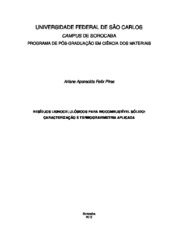| dc.contributor.author | Pires, Ariane Aparecida Felix | |
| dc.date.accessioned | 2016-06-02T19:19:57Z | |
| dc.date.available | 2015-06-24 | |
| dc.date.available | 2016-06-02T19:19:57Z | |
| dc.date.issued | 2013-10-31 | |
| dc.identifier.citation | PIRES, Ariane Aparecida Felix. Lignocellulosic residues for solid biofuel: characterization and applied thermogravimetry. 2013. 102 f. Dissertação (Mestrado em Materiais Funcionais e Polímeros de Fontes Renováveis) - Universidade Federal de São Carlos, Sorocaba, 2013. | por |
| dc.identifier.uri | https://repositorio.ufscar.br/handle/ufscar/1180 | |
| dc.description.abstract | The biomass research for use as a biofuel has been increasing worldwide encouraged by the search for viable alternatives of renewable energy. Part of the biomass, lignocellulosic residues can be used to generate bioenergy from its combustion, and a way to use the material and add value to the final product. However, it is necessary to know deeply the properties and physicochemical characteristics of a material before employing it as solid biofuel, thus qualifying it beforehand and understand their behavior during combustion and calorific value. Basically, for application as solid biofuel, a material must have homogeneous particle size, moisture content suitable, low ash content and high calorific value, in addition to substantial market supply and availability of these residues. It is known that the chemical composition of a lignocellulosic material is directly affects its energy performance, high percentages of lignin, α-cellulose and carbon are related to a higher calorific value and combustion slower, increasing the durability of the burning fuel. In the search for materials that meet these requirements, this work studied the sugar cane bagasse and the Eucalyptus sp. and Pinus sp. Sawdust, employing physicochemical analysis and thermogravimetry. From the thermogravimetric analysis of integrals lignocellulosic residues was possible to determine their lignin contents and fixed carbon and relates them to the results obtained by conventional analysis. The TG and DTG curves were studied for better understanding of the behavior of thermal degradation characteristic of integral plant biomass and its major components. The TG curve of lignin extracted from Eucalyptus sp. showed a higher thermal stability compared to other materials lignins. The results obtained for Eucalyptus sp. sawdust were the most satisfactory: lower ash content (0.46%), high lignin content (30.41%), higher carbon content (46.80%) and a higher calorific value (4415.3 kcal.kg-1), corresponding to the requirements necessary for a quality solid biofuel. | eng |
| dc.description.sponsorship | Financiadora de Estudos e Projetos | |
| dc.format | application/pdf | por |
| dc.language | por | por |
| dc.publisher | Universidade Federal de São Carlos | por |
| dc.rights | Acesso Aberto | por |
| dc.subject | biomassa | por |
| dc.subject | biocombustíveis | por |
| dc.subject | termogravimetria | por |
| dc.subject | biomass | eng |
| dc.subject | biofuels | eng |
| dc.subject | thermogravimetry | eng |
| dc.title | Resíduos lignocelulósicos para biocombustível sólido: caracterização e termogravimetria aplicada | por |
| dc.title.alternative | Lignocellulosic residues for solid biofuel: characterization and applied thermogravimetry | eng |
| dc.type | Dissertação | por |
| dc.contributor.advisor1 | Yamaji, Fábio Minoru | |
| dc.contributor.advisor1Lattes | http://lattes.cnpq.br/4787449634914831 | por |
| dc.contributor.referee1 | Morais, Leandro Cardoso de | |
| dc.contributor.referee1Lattes | http://lattes.cnpq.br/9900570420098740 | por |
| dc.contributor.referee2 | Martins, Mariana Provedel | |
| dc.contributor.referee2Lattes | http://lattes.cnpq.br/7358777976533179 | por |
| dc.description.resumo | A pesquisa de biomassa para aplicação como biocombustível vem se destacando em todo o mundo impulsionada pela busca de alternativas viáveis de fontes renováveis de energia. Parte da biomassa vegetal, os resíduos lignocelulósicos podem ser utilizados na geração de bioenergia a partir da sua combustão, constituindo uma forma de aproveitamento do material e agregação de valor ao produto final. Contudo, necessita-se conhecer profundamente as propriedades e características físico-químicas de um material antes de empregá-lo como biocombustível sólido, para assim qualificá-lo previamente e compreender seu comportamento durante combustão e poder calorífico. Basicamente, para aplicação como biocombustível sólido, um material deve possuir granulometria homogênea, teor de umidade adequado, um baixo teor de cinzas e alto poder calorífico aliados a uma grande oferta no mercado e disponibilidade destes resíduos. Sabe-se que a composição química de um material lignocelulósico afeta diretamente seu desempenho energético, sendo que elevados percentuais de lignina, α-celulose e carbono estão relacionados a um maior poder calorífico e a uma combustão mais lenta, elevando a durabilidade do combustível na queima. Na busca por materiais que atendam a esses requisitos, este trabalho estudou o bagaço de cana-de-açúcar e as serragens de Eucalyptus sp. e Pinus sp., empregando análises físico-químicas e termogravimetria. A partir da análise termogravimétrica dos resíduos lignocelulósicos integrais foi possível determinar seus conteúdos de lignina e carbono fixo e relacioná-los com os resultados obtidos pela análise convencional. As curvas TG e DTG foram estudadas para a maior compreensão do comportamento de degradação térmica característico da biomassa vegetal integral e de seus componentes majoritários. A curva TG da lignina extraída do Eucalyptus sp. demonstrou uma maior estabilidade térmica em relação às ligninas dos outros materiais. Os resultados obtidos para a serragem de Eucalyptus sp. foram os mais satisfatórios: menor teor de cinzas (0,46%), alto conteúdo de lignina (30,41%), maior teor de carbono (46,80%) e um maior poder calorífico superior (4415,3 kcal.kg-1), correspondendo aos requisitos necessários a um biocombustível sólido de qualidade. | por |
| dc.publisher.country | BR | por |
| dc.publisher.initials | UFSCar | por |
| dc.publisher.program | Programa de Pós-Graduação em Ciência dos Materiais - PPGCM-So | por |
| dc.subject.cnpq | OUTROS | por |
| dc.contributor.authorlattes | http://lattes.cnpq.br/2424682538346982 | por |
